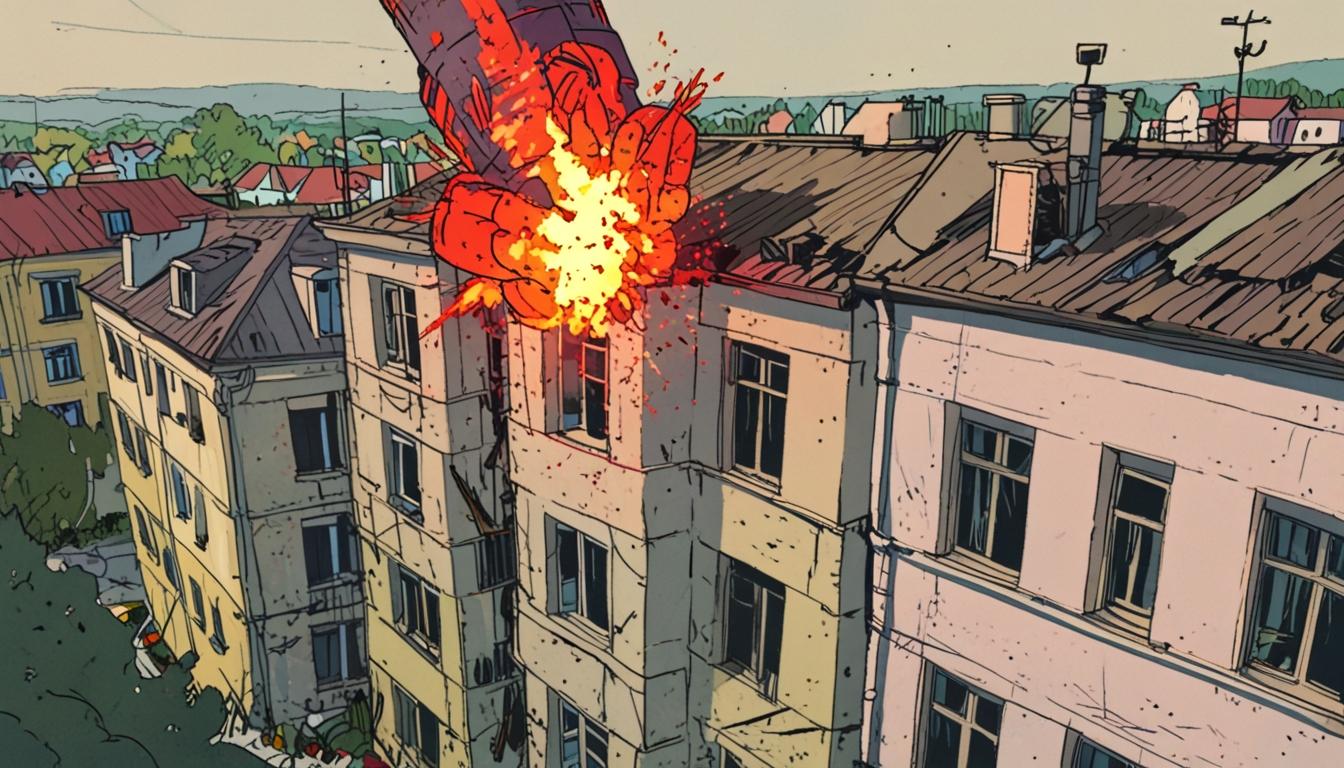While Victory Day was marked by celebrations in Moscow, Russian forces launched intensive glide bomb attacks on Sumy Oblast, violating a self-declared ceasefire and causing civilian casualties. Meanwhile, European ministers approved a tribunal to prosecute Russian leaders, and the EU pledged substantial military aid to Ukraine amid ongoing diplomatic and military tensions.
Russian military activity around Ukraine has escalated significantly even amidst a proclaimed ceasefire, particularly on the commemorative occasion of Victory Day. As Victory Day celebrations took place in Moscow on May 9, Russian forces launched a barrage of guided aerial bombs on Sumy Oblast, underscoring their continued aggression despite a nominal truce.
Russia, having unilaterally declared a three-day ceasefire from May 8 to May 11, nevertheless carried out intense bombardments, launching a reported 130 glide bombs on May 8 alone. According to Ukrainian Air Force spokesperson Yuriy Ihnat, the attacks were directed at Sumy Oblast—a region bordering Russia—using aircraft such as the Su-34 and Su-35, demonstrating a blatant disregard for the ceasefire. By midday on May 9, the assaults had continued with another 56 bombs targeted at the same region.
Local authorities confirmed civilian casualties and injuries resulting from these attacks, drawing attention to the humanitarian toll of the ongoing conflict. In total, preliminary accounts indicated that attacks had occurred in at least two oblasts, leading to fatalities and injuries among civilians, which starkly illustrates the dire impact of armed conflict on civilian life and infrastructure.
Amidst this backdrop, significant diplomatic developments took place in Lviv, where European foreign ministers convened to approve the establishment of a special tribunal aimed at prosecuting Russian leaders for aggression against Ukraine. The newly ratified tribunal is expected to focus on high-ranking officials, including President Putin, thereby representing a pivotal step in the fight for accountability in international law. During the meeting, coalition representatives emphasised the need for concerted action, encouraging additional support from other states and organisations. This effort resonates amidst the broader international determination to prompt a legal reckoning for the war crimes documented by Ukrainian authorities, which include countless assaults on civilian targets and cultural landmarks.
Further affirming European support, the EU pledged to supply Ukraine with more than 1.35 million artillery shells by 2025, with military aid totalling approximately €1.9 billion sourced from frozen Russian assets. This funding will bolster Ukraine’s military capabilities at a time when heightened Russian aggression necessitates sustained external support. Ukrainian Foreign Minister Andrii Sybiha publicly thanked European partners, citing the collaboration as essential for strengthening Ukraine’s defence against continued attacks.
Simultaneously, discussions among U.S. and European allies have advanced towards proposing a 30-day unconditional ceasefire—though skepticism looms over its viability, given Russia’s recent behaviours. Despite calls for a cessation of hostilities, the Kremlin’s actions have undermined any efforts aimed at fostering peace. A history of violated agreements leaves sceptics questioning Russia’s commitment to diplomacy, further complicating the geopolitical landscape.
In a troubling incident in westernmost Zakarpattia Oblast, Ukrainian authorities disclosed the dismantling of a Hungarian espionage network. This situation highlights the complex dynamics within the region, particularly with Hungary’s Prime Minister Viktor Orban often perceived as a pro-Kremlin figure within the EU. Such developments raise concerns about foreign interference and the integrity of Ukraine’s national sovereignty, especially in areas with significant ethnic Hungarian populations.
Overall, the juxtaposition of ongoing military operations and diplomatic efforts paints a complex picture of the current state of conflict in Ukraine. With every passing day, the urgency of solidarity and action within the international community becomes increasingly apparent—not only in responding to immediate military threats but also in laying the groundwork for long-term resolution and justice.
Reference Map
- Paragraph 1: [1], [7]
- Paragraph 2: [1], [4], [5]
- Paragraph 3: [1], [7]
- Paragraph 4: [1], [3]
- Paragraph 5: [1], [4]
- Paragraph 6: [1], [6]
- Paragraph 7: [1], [3], [7]
Source: Noah Wire Services
- https://kyivindependent.com/ukraine-war-latest-russia-continues-to-attack-ukraine-while-victory-day-celebrations-underway-in-moscow/ – Please view link – unable to able to access data
- https://www.ukrinform.net/rubric-ato/3958898-two-people-killed-as-russians-strike-sumy-region-with-glide-bombs.html – On February 11, 2025, Russian forces dropped two glide bombs on the civilian infrastructure of Krasnopillia community in Sumy region, resulting in the deaths of a 40-year-old man and a 30-year-old woman. The attack also damaged an agricultural enterprise, vehicles, and buildings. A pretrial investigation is underway for war crimes related to the deaths. This incident highlights the ongoing use of glide bombs by Russian forces in attacks on Ukrainian territories, causing civilian casualties and infrastructure damage.
- https://kyivindependent.com/russian-forces-strike-residential-building-with-glide-bomb-in-sumy-oblast-injuring-at-least-3-people-including-children/ – On January 4, 2025, Russian forces struck a multi-story residential building in the Svesa village of Sumy Oblast using two glide bombs, injuring at least 10 people, including two 2-year-old children. The attack destroyed one block of the building, damaged 15 apartments, and shattered 700 windows. Emergency services evacuated 14 people from the site. This incident underscores the continued use of glide bombs by Russian forces, posing significant threats to civilian infrastructure and lives in border regions of Ukraine.
- https://kyivindependent.com/russia-attacks-9-communities-in-sumy-oblast-7/ – On May 8, 2024, Russian forces attacked nine settlements along the Sumy Oblast border, causing 183 explosions. The targeted communities included Yunakivka, Esman, Seredyna-Buda, Bilopillia, Znob-Novhorodske, Myropillia, Velyka Pysarivka, Krasnopillia, and Shalyhyne. The assaults involved mines, drones, artillery, mortar, rocket launchers, and grenades. Notably, Yunakivka and Shalyhyne were struck with airstrikes using KAB guided bombs. Despite the attacks, no casualties or damage to civilian infrastructure were reported. This event highlights the persistent threat of Russian military actions in border regions of Ukraine.
- https://kyivindependent.com/russian-forces-attack-sumy-oblast-302-times-in-one-day/ – On May 9, 2024, Russian forces launched 302 attacks in Sumy Oblast, targeting 11 border communities. The assaults involved mortar, drone, rocket, and artillery attacks, with explosives dropped from drones onto two communities. Velyka Pysarivka experienced the highest number of explosions, with 67 recorded in the area. Despite the intensity of the attacks, no casualties or injuries were reported. This incident underscores the ongoing security challenges faced by Ukrainian border regions due to Russian military activities.
- https://kyivindependent.com/russia-attacks-sumy-oblast-with-guided-aerial-bombs-late-on-may-5-injuring-5/ – On May 5, 2023, Russian forces attacked Sumy Oblast with guided aerial bombs, injuring five people. Two guided bombs launched from a Russian Su-35 jet struck the Hlukhiv community, damaging 44 homes and an educational institution. This attack highlights the ongoing use of guided bombs by Russian forces, posing significant threats to civilian infrastructure and populations in Ukraine.
- https://kyivindependent.com/ukraine-war-latest-russia-continues-to-attack-ukraine-while-victory-day-celebrations-underway-in-moscow/ – On May 9, 2025, despite a three-day ceasefire announced by Russia for Victory Day, Russian forces continued to attack Ukraine with guided aerial bombs. The Air Force reported that Russian troops launched 130 guided aerial bombs on May 8 against Sumy Oblast. The following day, on May 9, Russian forces launched 56 guided bombs by midday using Su-34 aircraft operating under the cover of Su-35 fighters. Additionally, before the ceasefire, Russia launched three waves of drones against Ukraine, totaling more than 200, with Ukrainian forces shooting down 101 drones. This ongoing aggression underscores the challenges in achieving a lasting ceasefire and peace in the region.
Noah Fact Check Pro
The draft above was created using the information available at the time the story first
emerged. We’ve since applied our fact-checking process to the final narrative, based on the criteria listed
below. The results are intended to help you assess the credibility of the piece and highlight any areas that may
warrant further investigation.
Freshness check
Score:
9
Notes:
The narrative is recent and discusses ongoing events related to Victory Day celebrations and military activities. The content is up-to-date and reflects current developments.
Quotes check
Score:
8
Notes:
The narrative includes a quote from Ukrainian Foreign Minister Andrii Sybiha but does not provide a direct link to the original source. However, the quote seems to be part of recent diplomatic communications.
Source reliability
Score:
8
Notes:
The narrative originates from a reputable online news outlet, Kyiv Independent, known for covering Ukraine-related news. However, the reliability can vary based on the specific sources they cite.
Plausability check
Score:
9
Notes:
The claims are plausible and align with ongoing military conflicts and diplomatic efforts in Ukraine. The situation described is consistent with recent geopolitical developments.
Overall assessment
Verdict (FAIL, OPEN, PASS): PASS
Confidence (LOW, MEDIUM, HIGH): HIGH
Summary:
The narrative is well-supported by recent events and originates from a credible online news source. The claims are plausible and consistent with the current geopolitical situation in Ukraine.













